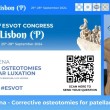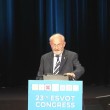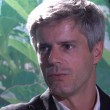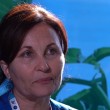
Jeffrey J Thomason, BA, MSc, PhD
Professor of Biomedical Sciences
Ontario Veterinary College
University of Guelph
G.S-S. Jeff, it would be helpful to readers if they could learn about your early education in biological field and what led you to concentrate on the skeleton as an organ
J.T. Bones first attracted my interest in an undergraduate course in vertebrate palaeontology at Cambridge. When I followed up on that stimulus, and arrived at the University of Toronto to do a Masters, my new supervisor, the eclectic and energetic Chris McGowan, showed me some sections of the exquisite arrangement of trabeculae in ichthyosaur vertebrae. He asked if it were possible to infer the external loads that stimulated their alignment. That single question set the directions taken by my career to date.
G.S-S. How did you make the transition from ichthyosaurs to horses?
J.T. Two of the senior graduate students in vertebrate palaeontology – Ann Holland and Rosemary Johnson – took me under their wing, upgrading my knowledge of comparative anatomy for the course in which we were all lab assistants. They were also great sounding boards for my fledging ideas on the conceptual difficulties in evaluating function from form in fossil animals, or even in living ones for that matter. We arrived fairly quickly at the conclusion that a tolerably robust way of assessing loading on fossil bones would be first to compare bone structure and loading for a living relative. Then by comparing the bone structure between the fossil and living forms, supportable inferences could be made about the possible loading experienced by the fossil bones during life. It was Ann who observed that the horse family has a well known evolutionary history, represented by many fossil forms, and also has a living representative whose biomechanics has and still continues to be studied in some detail. So my MSc was on the structure and function of the third metacarpal in Equus, and my PhD was extrapolating that work back to the metacarpals of two extinct three-toed equids, Mesohippus and Merychippus.
G.S-S. I recall some of your early work at Guelph was concerned with the equine hoof and I believe that you had some interesting findings regarding its loading when in motion. Can you summarise that work please?
J.T. From the thesis work on cannon bone structure and mechanics it was a short distance to the hoof, but it took me seven years to get there. In between I held a postdoctoral appointment in Calgary, and a faculty position at The Ohio University, in which I switched to some of the structure-function relationships for the cranial skeleton, working mainly on the opossum. Once I arrived in Guelph picking up the horse work became logistically easy, and that rapidly came back into prominence. The early work at Guelph on the hoof was on the strains experienced in the wall under a variety of locomotory conditions (different gaits and speeds, turning or on the straight, with and without a rider, etc.), backed up with computer models that illustrated the stress and strain in deeper tissues that were not readily accessible to strain gauges. I was interested in the modifications necessary to allow a fingernail to become the primary interface between the musculoskeletal system and the somewhat unpredictable terrain underfoot. Not surprisingly, we found a huge safety factor between the peak strains during normal operation of 5000-7000 microstrain and the strains at which the material fails of around 150,000 microstrain, as reported by John Bertram. The safety factor accommodates for considerable unpredictability in loading. We also dispelled the long held interpretation of the tubules that run proximodistally within the wall as springs that absorb the compressive loading on the hoof. If that were the case, peak strains would be expected to line up with the tubules, but they are often at 45 degrees to the tubules. The wall acts as a plywood – with tubules and intertubular material arranged orthogonally – that can resist strain in any direction.
G.S.-S. I know that you have a teaching commitment. Has that influenced your subsequent research work and you graduate students. What has been the thrust of your research work since then?
J.T. The personal satisfaction I gain from teaching goes a long way to defining who I am. Taking bright-eyed and bushy tailed first-year veterinary students from apprehension to a good degree of comprehension of mammalian anatomy is very rewarding. But anatomy is a very labour intensive course, because of the dissection lab component (though I rigorously combat any suggestion of completely replacing dissection with computer-based learning tools). Has the amount of teaching that I have committed to affected my research? Of course! A colleague when I was at The Ohio University quoted a statistic that the likelihood of maintaining federal funding for an independent research programme fell dramatically once the number of hours related to teaching (preparation, contact, marking, etc.) exceeded 300 per year. My teaching commitment has never been less that that while at Guelph. It is also difficult to attract large amounts of research funding for equine research in Ontario. So my programme, while successful in what it has accomplished, certainly operates on a modest scale. Over my 19 years at Guelph, the thrust of the research has become more applied, from musing on the mechanical design of heads and feet in the early years, to details of the role of track design on hoof loading and the relationship of hoof loading to injury in equine athletes. Recent projects have looked at the effects of banking, surface properties, shoes, and body and hoof size on limb loading.















